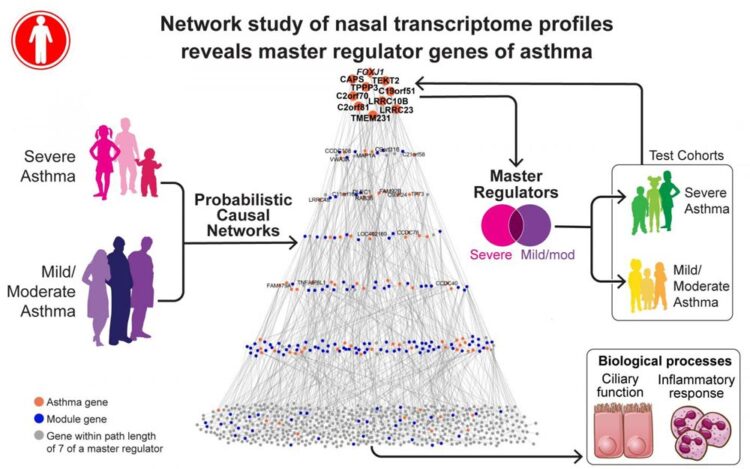Mount Sinai researchers identify master regulator genes of asthma

Graphical Abstract: Network study of nasal transcriptome profiles reveals master regulator genes of asthma
Credit: Mount Sinai
Insights provide new path forward in the study of asthma and the development of novel therapies
Researchers identify master regulator genes of asthma, provide new path forward in the study of asthma and the development of novel therapies.
Bottom Line: Identification of these master regulator genes provides a new path forward in the study of asthma and the development of novel therapies and treatments.
Results: After identifying nasal gene signatures for mild, moderate, and severe persistent asthma, the researchers applied probabilistic causal methods to identify master regulator genes and validated their results in independent cohorts. Researchers identified (1) a master regulator gene common to asthma across severity and ages (FOXJ1); (2) master regulator genes of severe persistent asthma in children (LRRC23, TMEM231, CAPS, PTPRC FYB); and (3) master regulator genes of mild/moderate persistent asthma in children and adults (C1orf38, FMNL1). The identified master regulators causally regulate the expression of downstream genes that modulate ciliary function and inflammatory response to influence asthma.
How: 156 children were recruited at Mount Sinai Health System in New York with severe persistent asthma as well as controls for nasal transcriptome profiling. Network-based and probabilistic causal methods were applied to identify severe asthma genes and their master regulators. The same approach was then taken in an independent cohort of 190 adults with mild/moderate asthma and controls to identify mild/moderate asthma genes and their master regulators. Comparative analysis of the master regulator genes followed by validation testing in independent children with severe asthma (n=21) and mild/moderate asthma (n=154) was then performed.
Said Mount Sinai’s Dr. Supinda Bunyavanich of the research: “Asthma is a common disease that affects people of all ages around the world. We studied nasal samples from children and adults with varying asthma severity not only to identify nasal signatures of mild, moderate, and severe asthma, but also to decipher master regulator genes that causally regulate key biological processes such as inflammatory response and ciliary function that underlie asthma. The master regulators we identified provide a novel path forward for uncovering mechanisms and novel therapy for asthma.”
###
About the Mount Sinai Health System
The Mount Sinai Health System is New York City’s largest academic medical system, encompassing eight hospitals, a leading medical school, and a vast network of ambulatory practices throughout the greater New York region. Mount Sinai is a national and international source of unrivaled education, translational research and discovery, and collaborative clinical leadership ensuring that we deliver the highest quality care–from prevention to treatment of the most serious and complex human diseases. The Health System includes more than 7,200 physicians and features a robust and continually expanding network of multispecialty services, including more than 400 ambulatory practice locations throughout the five boroughs of New York City, Westchester, and Long Island. The Mount Sinai Hospital is ranked No. 14 on U.S. News & World Report’s “Honor Roll” of the Top 20 Best Hospitals in the country and the Icahn School of Medicine as one of the Top 20 Best Medical Schools in the country. Mount Sinai Health System hospitals are consistently ranked regionally by specialty by U.S. News & World Report.
For more information, visit https:/
Media Contact
All latest news from the category: Health and Medicine
This subject area encompasses research and studies in the field of human medicine.
Among the wide-ranging list of topics covered here are anesthesiology, anatomy, surgery, human genetics, hygiene and environmental medicine, internal medicine, neurology, pharmacology, physiology, urology and dental medicine.
Newest articles

High-energy-density aqueous battery based on halogen multi-electron transfer
Traditional non-aqueous lithium-ion batteries have a high energy density, but their safety is compromised due to the flammable organic electrolytes they utilize. Aqueous batteries use water as the solvent for…

First-ever combined heart pump and pig kidney transplant
…gives new hope to patient with terminal illness. Surgeons at NYU Langone Health performed the first-ever combined mechanical heart pump and gene-edited pig kidney transplant surgery in a 54-year-old woman…

Biophysics: Testing how well biomarkers work
LMU researchers have developed a method to determine how reliably target proteins can be labeled using super-resolution fluorescence microscopy. Modern microscopy techniques make it possible to examine the inner workings…





















